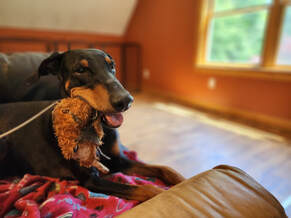| | As my dog's performance improves or is at least manageable in less distractions, then I start pushing the distractions a bit at a time. I want to challenge my dog but not totally overwhelm them. For me this becomes a judgement call. I can wait for more perfect performance in non distractions. I can also increase their performance in non distractions by pushing them a little bit when I am fairly sure they can handle it. I decide later whether that ended up being a bad idea or a good idea. With LaLa, it was a good idea as she did better than expected around distractions. Her biggest distraction is my husband, Robert, moving in and out of her view BTW. Next biggest distraction would be critters, but they are definitely second place to Robert. |
Week 5 LaLa Training Blog: More Exposure to Outside Distractions and Dropping the Leash Inside6/2/2024
 Training my own new dog, Laurel/LaLa, comes with it's own doubts. This is especially true when you have not had a new dog for 11 years. Luckily though, I am a dog trainer and do this with client dog's that I am getting to know all the time. I do have a basic format for my training, although it can change with individual dogs. On our first week, I did have some time (as I was on vacation for some of it) to do two hour days. So that is never training two hours in a row (except maybe in the future on walks, as the dog does not really know they are training and are jazzed up to be out). The longest times are behavioral or calming exercises which generally last for 15-30 minutes plus. Then obedience exercises may be sprinkled through the day from 5-15 minute sessions, depending on what we are working on. I include play training as obedience sessions as that is what I am working towards, even if we are not at the obedience part at first. Although, while LaLa likes to play, she is not really interested in balls, frisbees, or flirt poles towards that purpose at the moment. Maybe she will grow into that.  Our Shana with her "treasure" after a flirt pole training session of send to two places. After this, she fell into a deep sleep. Our Shana with her "treasure" after a flirt pole training session of send to two places. After this, she fell into a deep sleep. Why should someone consider adding play training to their dog training routine? I say add, because I am never just play training. For instance, if I am on a busy city street and we have some training to do, I probably am not going to use my flirt pole, frisbee, or ball to start a training session. I may use food as play or just as a standard reward. I may also use to do a subtle form of traditional training or management. So for those reasons, I don't believe you can get away with just play training your dog, although I would not have a problem with it if I could figure out how! So then the question is, why add play training in? How Do You Use Play Training for Impulse Control? What is Impulse Control? (Part 3 of 4 Series)6/7/2023  This is Shana demonstrating some impulse control while we play and food train. Sometimes I use just food reward or just toy reward. In this instance, I am using both food and toy. Shana's impulse is to rip the toy apart right before my eyes OR not give it up at all. Impulse control is when the dog is not doing something that they would like to do in the moment. When you are using play, they are controlling their impulse because they want the game to go on, instead of being corrected in more traditional training methods. Note: Our next blog will go over what play training provides for you that is different than traditional dog training, and why you might want to use it.  Play training focuses on the reward of play for engagement, enthusiasm, and motivation of the tasks, obedience, behavioral change, and relationship being formed. It sounds easy, right? The dog does this, and then we go and do that. The knowledge of the impending reward of continuing the game increases the likely hood of the behavior and/or performance that you want. In theory, it is easy. In practice, you can make mistakes that I would rather others avoid if possible.  In 2011 I came across a YouTube video of a trainer, Mike Ellis, who is a well known sports dog trainer. I hadn't heard of him, as he wasn't a fixture in pet dog training or AKC obedience. What he was doing absolutely blew me away, and he was having a seminar in RI the next week. I paid the very reasonable price to attend with a non working or audit spot (means you don't bring a dog to work and be coached), as all the working spots were filled. The seminar was called "Focus and Drive". This was the beginning of my play training journey. I am going to do a series on play training on this blog for the next few weeks (or more). |
Author, Robin RubinOwner and Head Dog Trainer in Maine, Robin Katherine Rubin, started her Maine dog training business in September 2004. Our dog training facility is located in Southern Maine in York Beach and we help families enjoy their dogs more, making sure they listen reliably and resolving unwanted behaviors. Archives
July 2024
Categories
All
|



 RSS Feed
RSS Feed